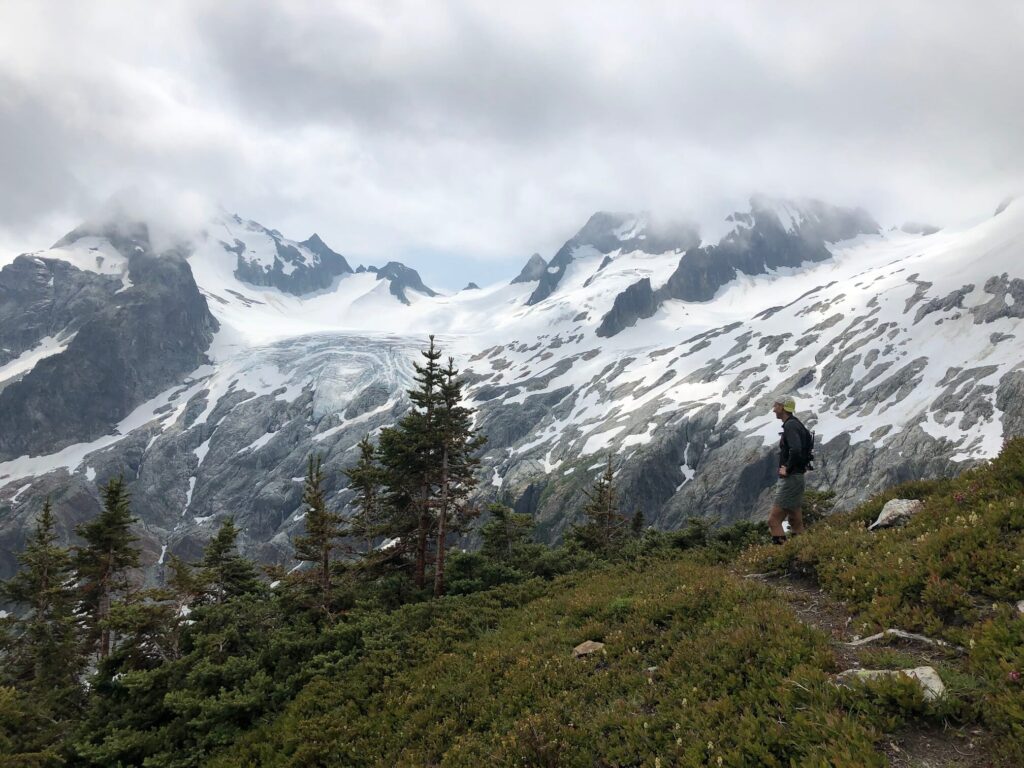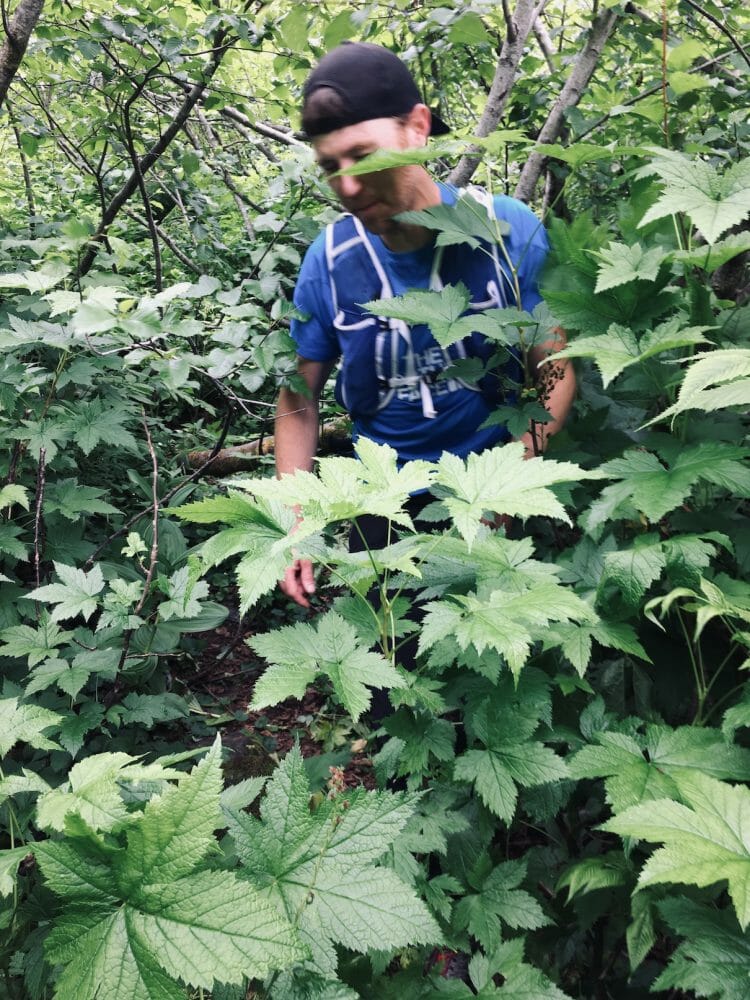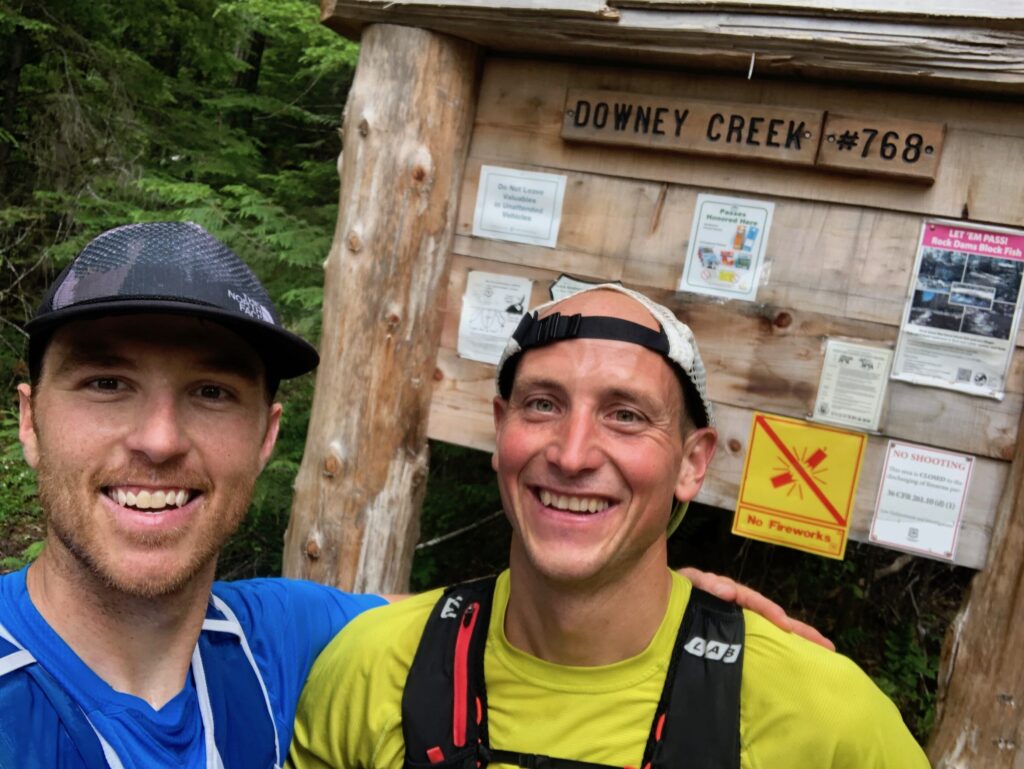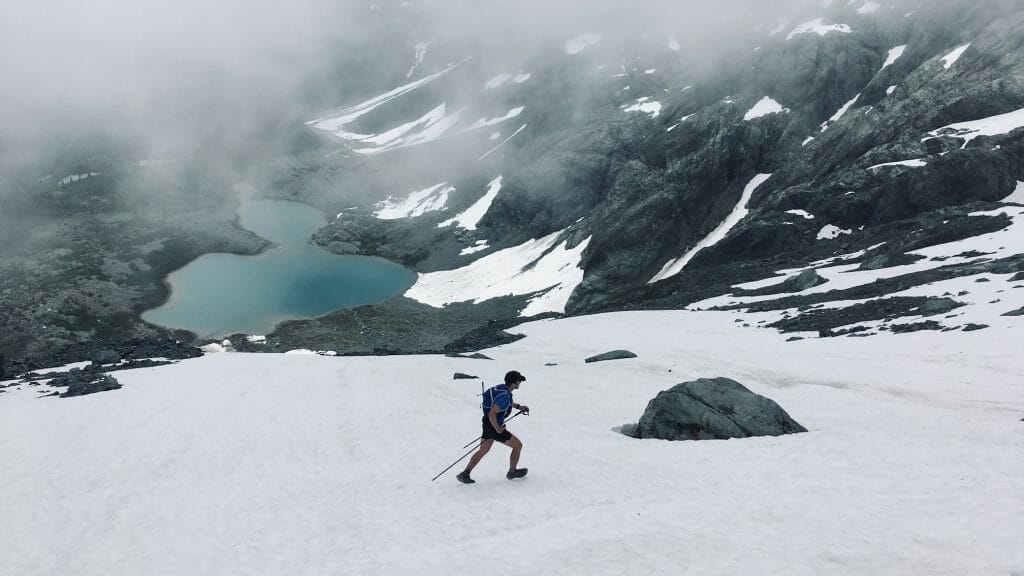Less than an hour into our Ptarmigan Traverse Fastest Known Time (FKT) attempt and I was wondering if we had picked the wrong day. It was wet, cold, low-visibility. Steven and I had just traded a well-worn trail for the start of what would be 25 miles of technical terrain.
Oh boy, I thought. This is going to be a really long day.
The weather in the North Cascades is fickle in late June and early July. Steven and I had been monitoring the conditions for a couple of weeks, waiting for a decent window. Three days out, we committed to going for it on July 4, 2019. I made the 11-hour drive from my home in Missoula, Montana, to the tiny town of Marblemount, Washington.
Now it was as if we were running inside a ping-pong ball, low clouds and fog obscuring the views.
But it wasn’t storming, and it wasn’t hot. Beautiful scenery couldn’t distract us from the simple task of pushing forward. My initial doubts faded with the movement and I settled into my favorite style of mountain travel: navigating complex alpine landscapes—snow, steep slopes, third-class terrain—as efficiently as possible. I enjoy drawing on different skill sets like route-finding and glacier travel. It’s more engaging than running along a trail. It’s about solving problem after problem and covering ground with purpose.
Steven Gnam shares this ethos. I first met him in 2014 when he passed through Missoula on a tour for his photography book Crown of the Continent. We struck up a conversation, went for a run, and became fast friends. The following year he joined me and my adventure buddy Mike Wolfe as we traced 600 miles on foot from Missoula to Banff, exploring the same rugged ecosystem depicted in Steven’s book.
The Ptarmigan Traverse would bring us back to that sense of a wild edge—different region, similar spinal topography.

A brief parting of the clouds reveal the landscape Mike and Steven were moving through.
Most people complete the route, a 35-mile Pacific Northwest mountaineering classic with around 24,000 feet of elevation change, in three to five days. But doing it in a day isn’t unheard of. Back in 2012, runners Uli Steidl and Leor Pantilat set a new FKT of 12:17. Steven and I wanted to see if we could improve on their time.
Steven scouted the traverse over the course of two days just two weeks prior to our attempt. Based on the snow he encountered, we opted to leave our crampons behind. I threw a pair of microspikes into my pack but ultimately didn’t need them; Steven didn’t bring any. We packed ice axes just in case. Our gear strategy was to go as light as we could while still being safe. We’re both super comfortable and experienced on snow.
Beyond the axe and microspikes, I packed what I would for an ultra race: a rain jacket, gloves, a light hat, a headlamp, and a bunch of food—around 1,600 calories, a mix of gels, chews, waffles, and nut butter. Because the terrain would dictate our pace, Steven and I didn’t expect to burn as hot as we would in a race effort.
The night of July 3, we camped about a half hour from the Cascade Pass trailhead—our start. We woke up around 4 a.m. the next morning, had a cup of coffee, hung out. Then we drove to the trailhead and got going at 5:50 a.m. We used the first 4 trail miles as a warm-up. Once I got over the weather, my mood warmed up too.
Swapping leads, Steven and I fell into a comfortable, steady rhythm. We power-hiked the uphills, ran the flats and downhills where the terrain would allow it, and glissaded or shoe-skied down from the cols and passes. He pulled on the descents and I pulled on the climbs. Our efficiency carried over to changing layers, grabbing water out of streams, and eating. We did it all on the move. We communicated well.
It’s like “The Tortoise and the Hare.” If you settle into a nice pace and minimize your starting and stopping, it’s amazing the amount of ground you can cover. When we arrived at certain passes, cols, and lakes along the way, we could see how our splits compared to the prior FKT splits. Steven and I continued to chip away at Leor and Uli’s time throughout the day.

Descending out of the alpine, Steven and Mike encountered some mandatory PNW bushwhacking.
For an incredibly conditions-dependent route, we hit a sweet spot for snow. The coverage was great, and it was firm but not so firm that we couldn’t kick the edges of our shoes into it. It was ideal for quick travel, giving us confidence in our footing in even the most high-consequence sections. These included some 40-plus-degree slopes, where a fall would have meant a pretty long ride, and the Red Ledges, a tight ribbon of goat trail contouring a cliff face. We had no trouble skirting the few open crevasses on the glaciers.
Steven and I navigated using a GPX track that was incredibly accurate. This was especially helpful at high points where we couldn’t see much. To know we were headed in the right direction at the right bearing enabled us to keep pushing the pace.
Only once did we get significantly off-route. It happened early in the day when suddenly I found myself doing some fourth-class scrambling on wet heather slopes. This can’t be right, I thought. It took us a while to get back on course. Aside from that slip-up, there was next to no stopping to scratch our heads, wondering where we were.
Occasionally the clouds opened up and we could see across the valley or up to some of the peaks. Even these brief glimpses were impressive. The North Cascades are a surprisingly wild and vast landscape.
Steven and I plunged into the thick of that wildness for the 5-mile bushwhack along Bachelor Creek to the final homestretch of trail. No one loves bushwhacking—the original obstacle course—but we embraced it.
We hopped over trees, ducked under and through bushes, stepped over roots, and scrambled along streambeds. The devil’s club clawed at my pants. Every time I tried to run, I tripped. Rarely could I see more than a few feet in front of me. I quickly found that walking with intent was the way to go. There’s something to be said about going slow to go fast.
When we reached the Downey Creek Trail, we stopped and shook the rocks out of our shoes. Then we ran those last 6 trail miles as hard as we could. It was amazing to be able to turn the legs over after all the mountain scrambling.
Steven and I tagged the finish 9 hours and 50 minutes after leaving the start—a new Ptarmigan Traverse FKT.

Tired and happy at the Downey Creek trailhead.
As much as I love spending time alone in the mountains, there’s something really special about sharing an experience like this. Steven and I pushed and supported one another. We went up against our limits and saw what we’re capable of—together. We may have missed out on the spectacular views, but we moved with purpose through dynamic weather and landscapes. We lived what we love.
This article was originally published by Mike Foote.

